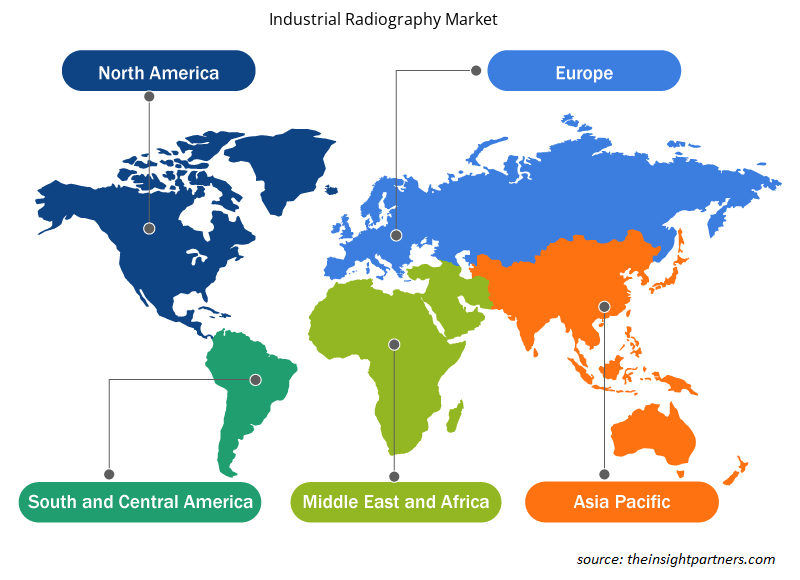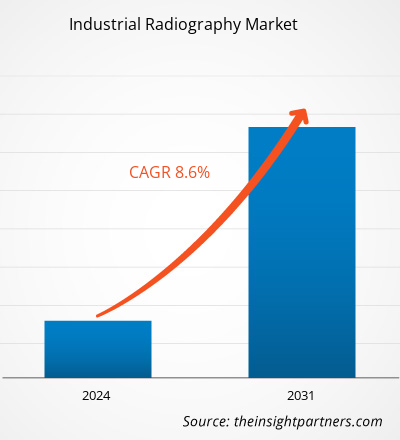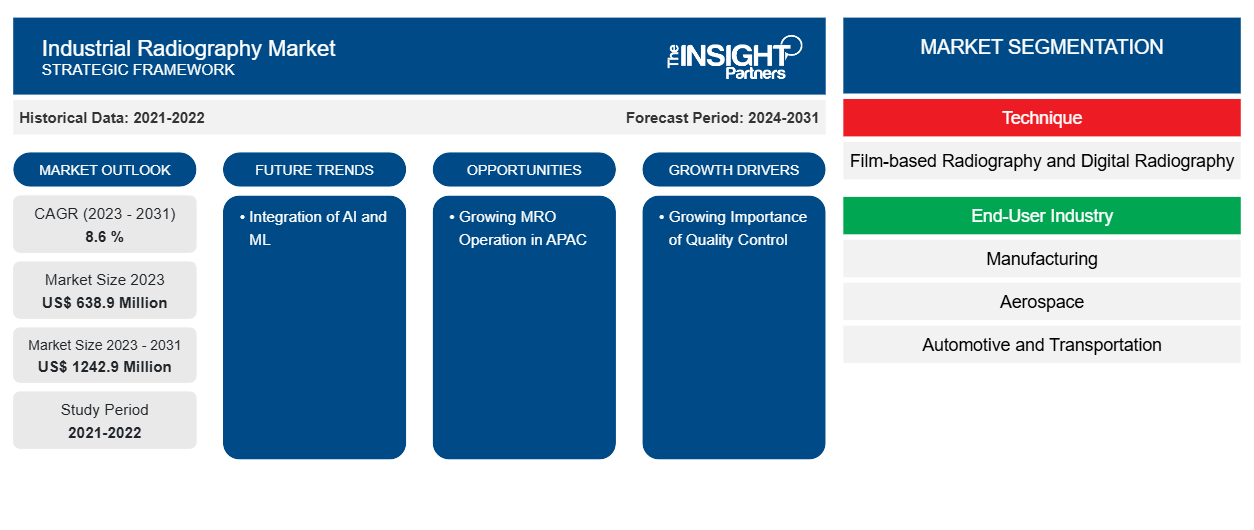산업용 방사선 촬영 시장 규모는 2023년 6억 3,890만 달러에서 2031년까지 1,242.9백만 달러로 성장할 것으로 예상됩니다. 이 시장은 2023~2031년 동안 8.6%의 CAGR을 기록할 것으로 예상됩니다. AI와 ML의 통합은 시장에서 핵심 트렌드로 남을 가능성이 높습니다.
산업용 방사선 촬영 시장 분석
산업용 방사선 촬영에서 검사자는 X선이나 감마선과 같은 이온화 방사선을 사용하여 재료와 구성 요소의 내부 구조를 분석합니다. 이를 통해 숨겨진 결함을 발견하고, 두께를 측정하고, 손상을 입히지 않으면서 다양한 구조의 무결성을 확인할 수 있습니다. 또한 유지 관리, 수리 및 운영이 증가함에 따라 시장이 성장하고 있습니다.
산업용 방사선 촬영 시장 개요
산업용 방사선 촬영은 이온화 방사선을 사용하여 재료와 구성 요소를 검사하여 엔지니어링 구조의 파손을 일으킬 수 있는 재료 품질의 결함과 저하를 감지하고 측정하는 비파괴 검사 방식입니다. 제조업체는 산업용 방사선 촬영을 사용하여 재료의 균열이나 결함을 감지합니다. 산업용 방사선 촬영은 주로 육안으로는 알 수 없는 결함을 드러내기 위해 X선과 감마선 을 사용합니다 . 산업용 방사선 촬영은 비파괴 유형의 물리적 검사입니다. 이 형태의 방사선 촬영은 규제된 조건에서 방사성 소스에서 방출되는 이온화 방사선을 사용하여 물체의 외부 형태에 아무런 해를 끼치지 않고 물체의 내부 구조를 감지하거나 결정합니다. 결과적으로 연구 중인 물건이나 제품의 구성 요소나 구성 요소를 명확하게 이해하는 데 사용할 수 있습니다.
귀하의 요구 사항에 맞게 이 보고서를 사용자 정의하세요
이 보고서의 일부 또는 국가 수준 분석, Excel 데이터 팩을 포함하여 모든 보고서에 대한 사용자 정의를 무료로 받을 수 있으며 신생 기업 및 대학을 위한 훌륭한 혜택과 할인 혜택을 이용할 수 있습니다.
-
이 보고서의 주요 시장 동향을 알아보세요.이 무료 샘플에는 시장 동향부터 추정 및 예측까지 다양한 데이터 분석이 포함됩니다.
산업용 방사선 촬영 시장 동인 및 기회
시장을 선호하는 품질 관리의 중요성 증가
품질 관리 산업용 방사선 촬영 검사관은 방사선 사진과 검사 방법의 전반적인 품질을 평가합니다. 그들은 검사가 산업 표준을 충족하고 장비가 제대로 작동하는지 보장합니다. 산업용 방사선 촬영은 주로 균열, 공극, 내포물 및 불연속성과 같은 재료 및 구조의 내부 결함을 감지하는 데 사용됩니다. 수많은 시스템 구성 요소의 구조적 무결성과 안전성을 보장합니다. 산업용 방사선 촬영은 금속, 폴리머 , 복합재 및 세라믹과 같은 재료를 평가하는 데 사용됩니다. 용접, 파이프라인, 주조, 단조, 항공 구성 요소 및 기타 항목은 모두 일반적으로 검사됩니다.
APAC에서 성장하는 MRO 운영MRO Operation in APAC
인도의 MRO 수요는 세계 평균보다 빠르게 확대될 것으로 예상되며, 이는 국내 및 해외 투자자, OEM 및 최고 MRO에 기회를 창출합니다. 국내 및 해외 투자자가 참여할 수 있습니다. 또한 아시아에서 가장 큰 MRO 기지가 있는 곳, Rolls Royce 및 Airbus와 같은 대형 산업 플레이어가 항공우주 산업에 많이 집중되어 있는 것이 아시아에서 MRO 운영이 성장하는 이유입니다. MRO는 많은 산업의 중요한 구성 요소입니다. 다음 산업은 MRO 관행을 많이 사용합니다. 제조업체는 제조 장비, 기계 및 도구에 대한 유지 관리 및 수리 활동에 광범위하게 의존합니다. 여기에는 자동차, 비행기, 전자 제품, 소비재 및 기타 산업이 포함됩니다. 항공사, 기차, 운송 및 물류를 포함하는 운송 사업은 자동차, 비행기, 기관차 및 운송 컨테이너 함대를 유지 관리하기 위해 MRO 기술에 의존합니다.
산업용 방사선 촬영 시장 보고서 세분화 분석
산업용 방사선 사진 시장 분석에 기여한 주요 부문은 기술과 최종 사용자 산업입니다.
- 산업용 방사선 촬영 시장은 기술에 따라 필름 기반 방사선 촬영과 디지털 방사선 촬영으로 구분됩니다.
- 산업용 방사선 촬영 시장은 최종 사용자 산업을 기준으로 제조, 항공우주, 자동차 및 운송, 발전, 석유화학 및 가스, 기타로 구분됩니다.
지역별 산업용 방사선 촬영 시장 점유율 분석
산업용 방사선 촬영 시장 보고서의 지리적 범위는 주로 북미, 아시아 태평양, 유럽, 중동 및 아프리카, 남미 및 중미의 5개 지역으로 나뉩니다. 북미의 산업용 방사선 촬영 시장은 미국, 캐나다, 멕시코로 세분화됩니다. 북미는 항공우주 및 방위 산업 기상 자동차 생산을 발전시켰습니다. 이 지역에는 Ford, Hona, Toyota, Tesla 등과 같은 다양한 유명 자동차 제조업체가 있습니다. 산업용 방사선 촬영의 주요 목적은 균열, 공극, 내포물 및 불연속성과 같은 재료 및 구조의 내부 결함을 감지하는 것입니다. 제조업체는 이를 사용하여 제품의 균열 또는 결함을 감지합니다.
산업용 방사선 촬영 시장 지역 통찰력
Insight Partners의 분석가들은 예측 기간 동안 산업용 방사선 촬영 시장에 영향을 미치는 지역적 추세와 요인을 철저히 설명했습니다. 이 섹션에서는 북미, 유럽, 아시아 태평양, 중동 및 아프리카, 남미 및 중미의 산업용 방사선 촬영 시장 세그먼트와 지리에 대해서도 설명합니다.

- 산업용 방사선 촬영 시장을 위한 지역별 특정 데이터 얻기
산업용 방사선 촬영 시장 보고서 범위
| 보고서 속성 | 세부 |
|---|---|
| 2023년 시장 규모 | 6억 3,890만 달러 |
| 2031년까지 시장 규모 | 12억 4,290만 달러 |
| 글로벌 CAGR (2023-2031) | 8.6% |
| 역사적 데이터 | 2021-2022 |
| 예측 기간 | 2024-2031 |
| 다루는 세그먼트 |
기술에 따라
|
| 포함된 지역 및 국가 |
북아메리카
|
| 시장 선도 기업 및 주요 회사 프로필 |
|
시장 참여자 밀도: 비즈니스 역학에 미치는 영향 이해
산업용 방사선 촬영 시장은 소비자 선호도의 변화, 기술 발전, 제품의 이점에 대한 인식 증가와 같은 요인으로 인해 최종 사용자 수요가 증가함에 따라 빠르게 성장하고 있습니다. 수요가 증가함에 따라 기업은 제품을 확장하고, 소비자의 요구를 충족하기 위해 혁신하고, 새로운 트렌드를 활용하여 시장 성장을 더욱 촉진하고 있습니다.
시장 참여자 밀도는 특정 시장이나 산업 내에서 운영되는 회사나 기업의 분포를 말합니다. 주어진 시장 공간에 얼마나 많은 경쟁자(시장 참여자)가 존재하는지 그 규모나 전체 시장 가치에 비해 나타냅니다.
산업용 방사선 시장에서 운영되는 주요 회사는 다음과 같습니다.
- 3D 엑스레이
- 안리쓰
- 혜성 그룹
- 후지필름 주식회사
- 제너럴 일렉트릭
- 메틀러 토레도
면책 조항 : 위에 나열된 회사는 어떤 특별한 순서에 따라 순위가 매겨지지 않았습니다.

- 산업용 방사선 촬영 시장의 주요 주요 업체 개요를 알아보세요
산업용 방사선 촬영 시장 뉴스 및 최근 개발
산업용 방사선 촬영 시장은 1차 및 2차 연구 이후의 질적, 양적 데이터를 수집하여 평가하는데, 여기에는 중요한 기업 출판물, 협회 데이터, 데이터베이스가 포함됩니다. 산업용 방사선 촬영 시장의 몇 가지 개발 사항은 다음과 같습니다.
- 영국 공군은 3DX-Ray에 ThreatScan-LSC 휴대용 X선 스캐닝 시스템(RAF) 3대를 공급하는 계약을 체결했습니다. ThreatScan-LSC는 기존 시스템을 대체할 것이며, 이는 3DX-First Ray가 RAF와 체결한 계약입니다.
(출처: 3DX-RAY, 2021년 1월)
- 고성능 X선 이미징 공급업체인 Teledyne Industrial X-Ray Solutions는 혁신적인 방사선 내성 IGZO 센서 기술을 기반으로 하는 고속, 고성능 산업용 동적 검출기의 새로운 제품군을 출시했습니다. Rad-Xcam 1717, 1723 및 3030 검출기는 산업 검사, 생물의학 및 과학 응용 분야의 까다로운 요구 사항을 해결하도록 설계되어 매력적인 통합 비용 이점을 제공합니다. (출처: Teledyne., 2023년 7월)
산업용 방사선 촬영 시장 보고서 범위 및 제공물
"산업용 방사선 촬영 시장 규모 및 예측(2021-2031)" 보고서는 아래 영역을 포괄하는 시장에 대한 자세한 분석을 제공합니다.
- 범위에 포함된 모든 주요 시장 세그먼트에 대한 글로벌, 지역 및 국가 수준의 산업용 방사선 촬영 시장 규모 및 예측
- 산업용 방사선 촬영 시장 동향과 드라이버, 제약 및 주요 기회와 같은 시장 역학
- 자세한 PEST/포터의 5가지 힘과 SWOT 분석
- 주요 시장 동향, 글로벌 및 지역 프레임워크, 주요 업체, 규정 및 최근 시장 개발 사항을 포괄하는 산업용 방사선 촬영 시장 분석
- 시장 집중도, 히트맵 분석, 유명 업체 및 산업용 방사선 시장의 최근 동향을 다루는 산업 환경 및 경쟁 분석
- 자세한 회사 프로필
- 과거 분석(2년), 기준 연도, CAGR을 포함한 예측(7년)
- PEST 및 SWOT 분석
- 시장 규모 가치/거래량 - 글로벌, 지역, 국가
- 산업 및 경쟁 환경
- Excel 데이터세트
최근 보고서
사용 후기
구매 이유
- 정보에 기반한 의사 결정
- 시장 역학 이해
- 경쟁 분석
- 고객 인사이트
- 시장 예측
- 위험 완화
- 전략 기획
- 투자 타당성 분석
- 신흥 시장 파악
- 마케팅 전략 강화
- 운영 효율성 향상
- 규제 동향에 발맞춰 대응























 무료 샘플 받기 - 산업용 방사선 촬영 시장
무료 샘플 받기 - 산업용 방사선 촬영 시장